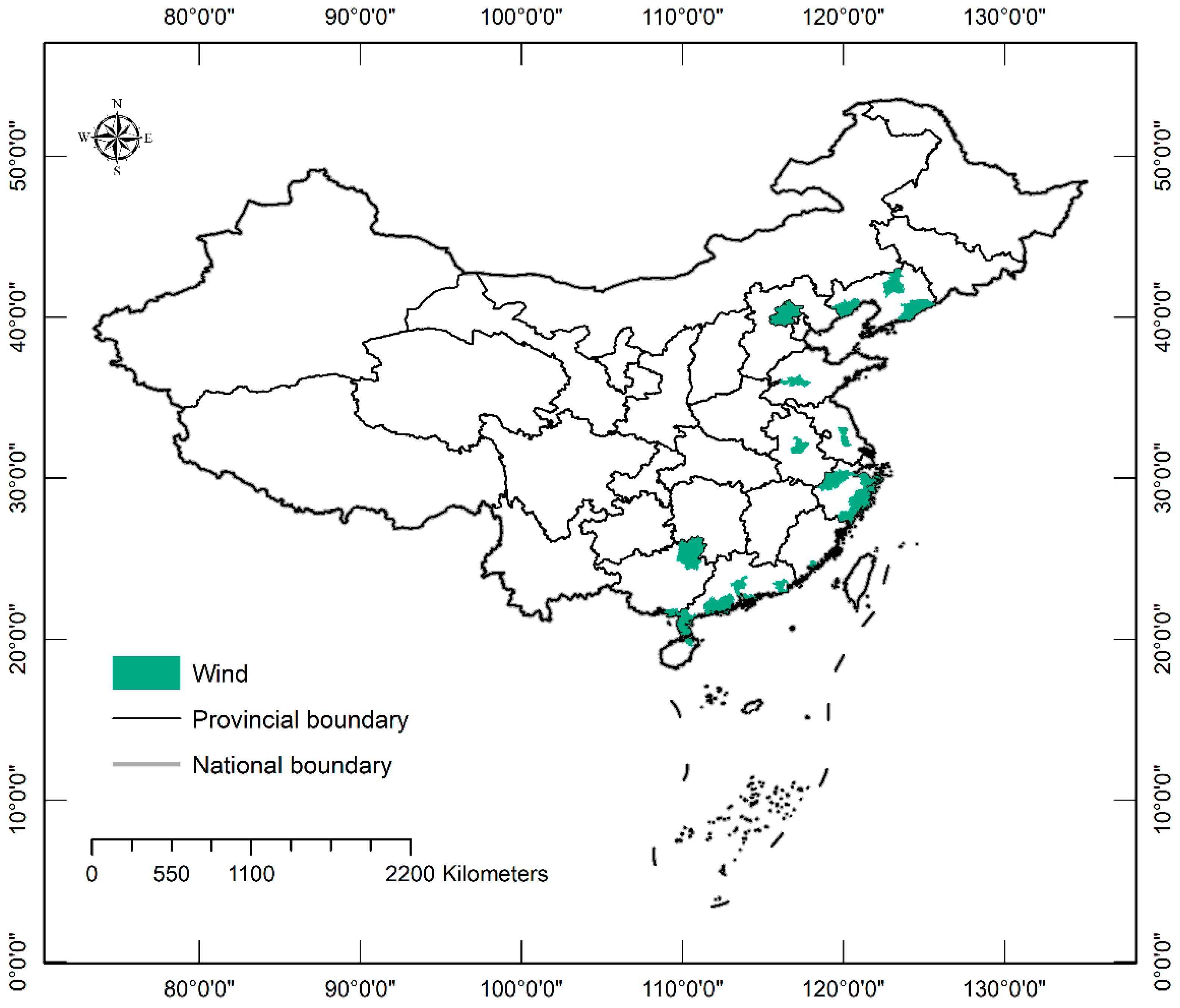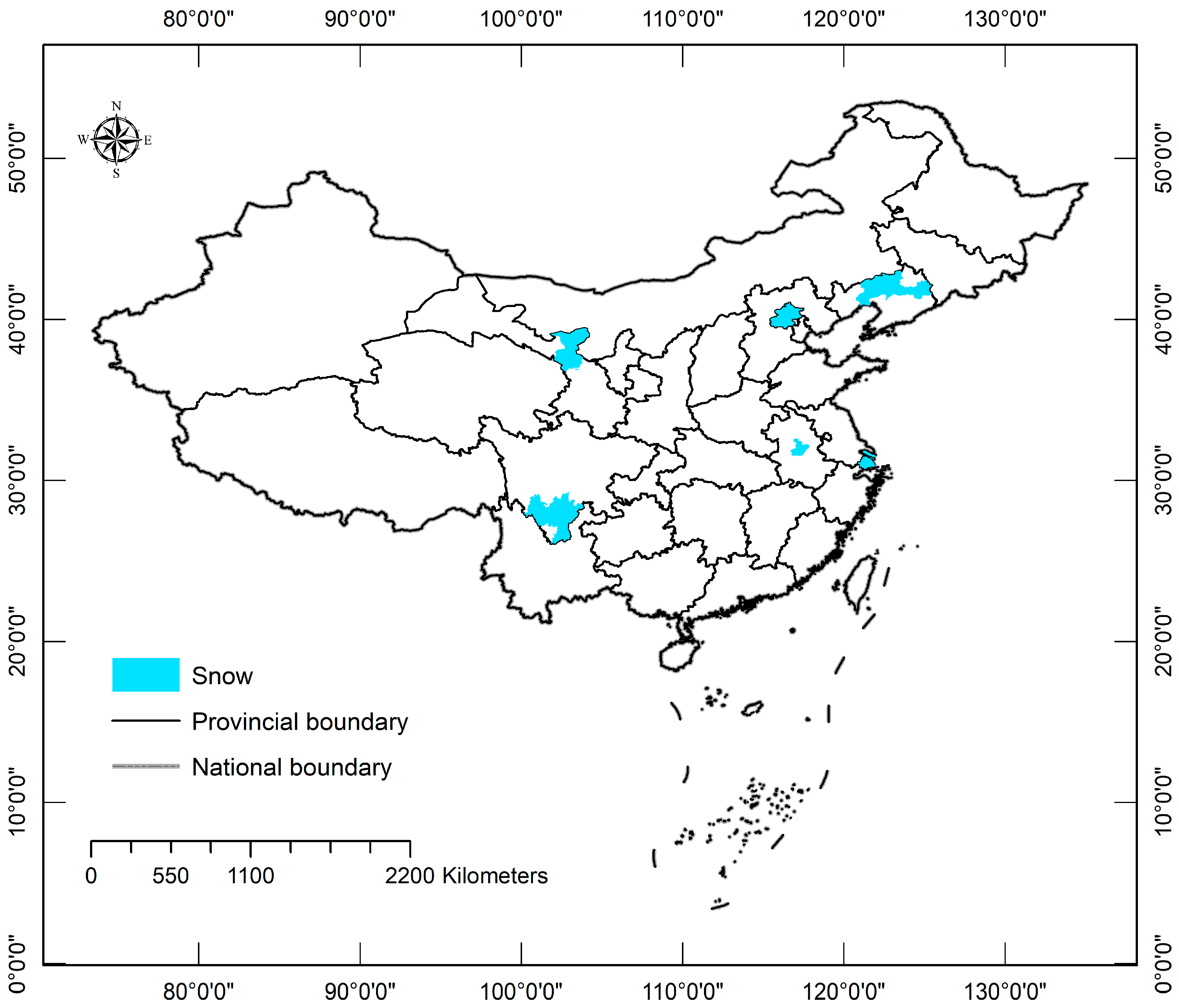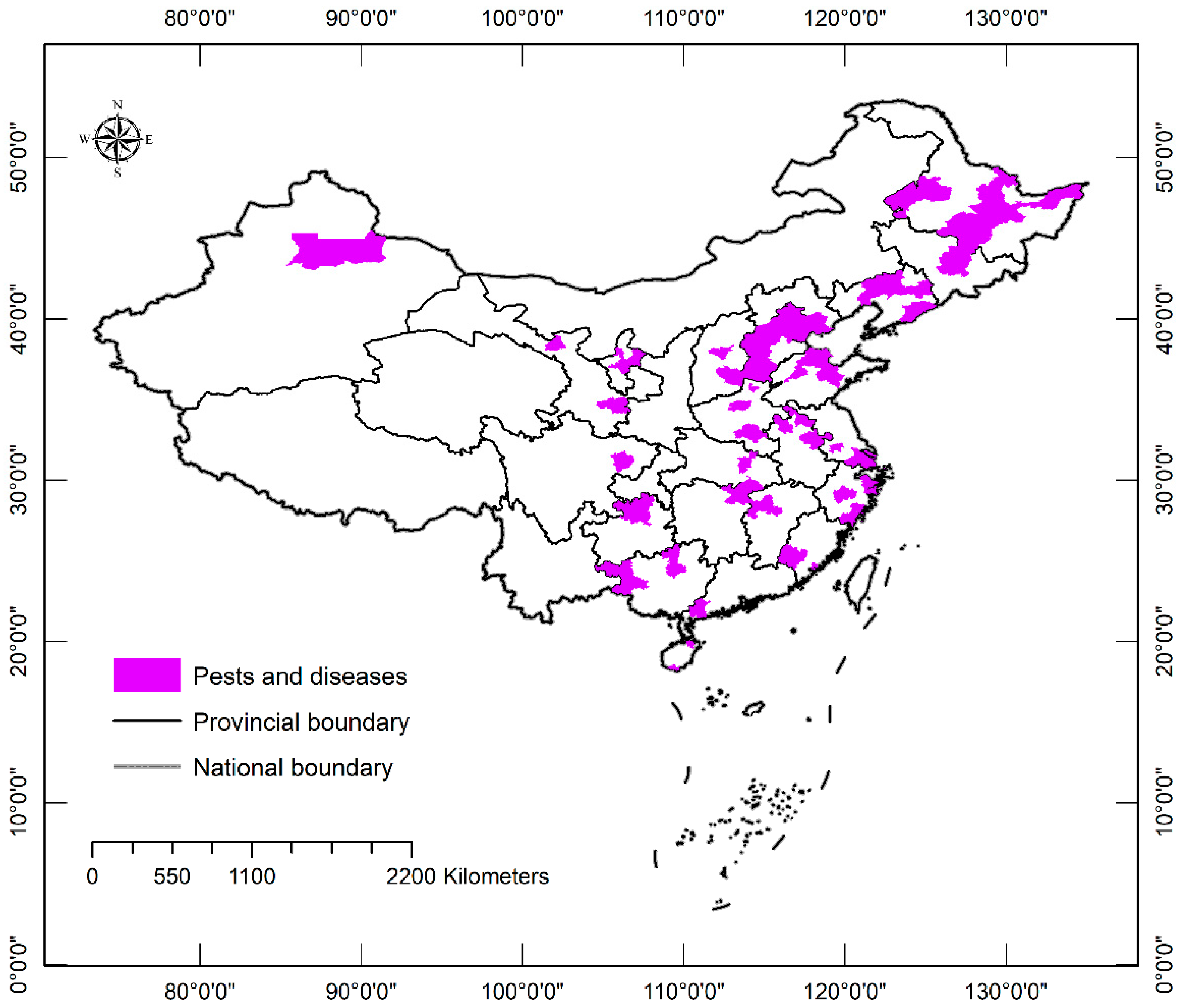Performances of Urban Tree Species under Disturbances in 120 Cities in China
Abstract
1. Introduction
2. Methods
2.1. Data Collection
2.2. Data Analysis
3. Results
3.1. Results of the Systematic Literature Search
3.2. The General Pattern of Occurrences of Disturbances on Urban Forests in China
3.3. Impacts Caused by Low and High Temperatures
3.4. Wind Impacts
3.5. Impacts of Snow
3.6. Impacts Caused by Diseases and Pests
4. Discussion
4.1. Spatial Patterns of Occurrences of Disturbances on Urban Trees in China
4.2. Susceptibility of Urban Tree Species to Disturbances
4.3. Implications of Findings
4.4. Limitations of the Current Study
5. Conclusions
Supplementary Materials
Acknowledgments
Author Contributions
Conflicts of Interest
References
- Bottalico, F.; Travaglini, D.; Chirici, G.; Garfì, V.; Giannetti, F.; De Marco, A.; Fares, S.; Marchetti, M.; Nocentini, S.; Paoletti, E.; et al. A Spatially-explicit Method to Assess the Dry Deposition of Air Pollution by Urban Forests in the City of Florence, Italy. Urban For. Urban Green. 2017, 27, 221–234. [Google Scholar] [CrossRef]
- Berland, A.; Shiflett, S.A.; Shuster, W.D.; Garmestanil, A.S.; Goddard, H.C.; Herrmann, D.L.; Hopton, M.E. The Role of Trees in Urban Stormwater Management. Landsc. Urban Plan. 2017, 162, 167–177. [Google Scholar] [CrossRef]
- Tan, Z.; Lau, K.K.L.; Ng, E. Urban Tree Design Approaches for Mitigating Daytime Urban Heat Island Effects in a High-density Urban Environment. Energy Build. 2016, 114, 265–274. [Google Scholar] [CrossRef]
- Jennings, T.E.; Jean-Philippe, S.R.; Willcox, A.; Zobel, J.M.; Poudyal, N.C.; Simpson, T. The Influence of Attitudes and Perception of Tree Benefits on Park Management Priorities. Landsc. Urban Plan. 2016, 153, 122–128. [Google Scholar] [CrossRef]
- Nitoslawski, S.A.; Duinker, P.N.; Bush, P.G. A Review of Drivers of Tree Diversity in Suburban Areas: Research Needs for North American Cities. Environ. Rev. 2016, 24, 471–483. [Google Scholar] [CrossRef]
- Tryjanowski, P.; Morelli, F.; Mikula, P.; Krištín, A.; Indykiewicz, P.; Grzywaczewski, G.; Kronenberg, J.; Jerzak, L. Bird Diversity in Urban Green Space: A Large-scale Analysis of Differences between Parks and Cemeteries in Central Europe. Urban For. Urban Green. 2017, 27, 264–271. [Google Scholar] [CrossRef]
- Scharenbroch, B.C.; Morgenroth, J.; Maule, B. Tree Species Suitability to Bioswales and Impact on the Urban Water Budget. J. Environ. Qual. 2016, 45, 199–206. [Google Scholar] [CrossRef] [PubMed]
- Dallimer, M.; Irvine, K.N.; Skinner, A.M.J.; Davies, Z.G.; Rouquette, J.R.; Maltby, L.L.; Warren, P.H.; Armsworth, P.R.; Gaston, K.J. Biodiversity and the Feel-Good Factor: Understanding Associations between Self-Reported Human Well-being and Species Richness. BioScience 2012, 62, 47–55. [Google Scholar] [CrossRef]
- Nakamura, A.; Morimoto, Y.; Mizutani, Y. Adaptive Management Approach to Increasing the Diversity of a 30-year-old Planted Forest in an Urban Area of Japan. Landsc. Urban Plan. 2005, 70, 291–300. [Google Scholar] [CrossRef]
- Ren, Y.; Ge, Y.; Ma, D.; Song, X.; Shi, Y.; Pan, K.; Qu, Z.; Guo, P.; Han, W.; Chang, J. Enhancing Plant Diversity and Mitigating BVOC Emissions of Urban Green Spaces through the Introduction of Ornamental Tree Species. Urban For. Urban Green. 2017, 27, 305–313. [Google Scholar] [CrossRef]
- Sjöman, H.; Morgenroth, J.; Sjöman, J.D.; Sæbø, A.; Kowarik, L. Diversification of the Urban Forest—Can We Afford to Exclude Exotic Tree Species? Urban For. Urban Green. 2016, 18, 237–241. [Google Scholar] [CrossRef]
- Bassuk, N.; Whitlow, T. Environmental Stress in Street Trees. Arboric. J. 1988, 12, 195–201. [Google Scholar] [CrossRef]
- Sjöman, H.; Busse Nielsen, A. Selecting Trees for Urban Paved Sites in Scandinavia—A Review of Information on Stress Tolerance and Its Relation to the Requirements of Tree Planners. Urban For. Urban Green. 2010, 9, 281–293. [Google Scholar] [CrossRef]
- Griffin, J.J.; Jacobi, W.R.; McPherson, E.G.; Sadof, C.S.; McKenna, J.R.; Gleason, M.L.; Gauthier, N.W.; Potter, D.A.; Smitley, D.R.; Adams, G.C.; et al. Ten-year Performance of the United States National Elm Trial. Arboric. Urban For. 2017, 43, 107–120. [Google Scholar]
- Poland, T.M.; McCullough, D.G. Emerald Ash Borer: Invasion of the Urban Forest and the Threat to North America’s Ash Resource. J. For. 2006, 104, 118–124. [Google Scholar]
- Yang, X.; Ma, J.; Li, Y.H. The Damaged 40,000 Camphor Tree in Lianyungang City Is Expected to Recover. Available online: http://js.people.com.cn/n2/2016/0322/c360304-27989802.html (accessed on 22 March 2016).
- Rummukainen, M. Changes in Climate and Weather Extremes in the 21st Century. Wiley Interdiscip. Rev. Clim. Chang. 2012, 3, 115–129. [Google Scholar] [CrossRef]
- Lohr, V.I.; Kendal, D.; Dobbs, C. Urban Trees Worldwide Have Low Species and Genetic Diversity, Posing High Risks of Tree Loss as Stresses from Climate Change Increase. Acta Hortic. 2016, 1108, 263–270. [Google Scholar] [CrossRef]
- National Bureau of Statistics of China. Census Data; National Bureau of Statistics of China: Beijing, China, 2016.
- Ministry of Housing and Urban-Rural Development of China. 2015 Report on the Statistics of Urban and Rural Development; Ministry of Housing and Urban-Rural Development: Beijing, China, 2016.
- Yang, J.; Huang, C.; Zhang, Z.; Wang, L. The Temporal Trend of Urban Green Coverage in Major Chinese Cities between 1990 and 2010. Urban For. Urban Green. 2014, 13, 19–27. [Google Scholar] [CrossRef]
- Jia, B.; Qiu, K. The Cooling Effect of Plain Afforestation in the Beijing Project and Its Remote Sensing-based Valuation. Acta Ecol. Sin. 2017, 37, 726–735. [Google Scholar]
- Liberati, A.; Altman, D.G.; Tetzlaff, J.; Mulrow, C.; Gøtzsche, P.C.; Ioannidis, J.P.A.; Clarke, M.; Devereaux, P.J.; Kleijnen, J.; Moher, D. The PRISMA Statement for Reporting Systematic Reviews and Meta-analyses of Studies that Evaluate Health Care Interventions: Explanation and Elaboration. PLoS Med. 2009, 6. [Google Scholar] [CrossRef] [PubMed]
- Zhang, J.; Gao, M.; Liu, X. Damage of High Temperature in Summer to the Gardening Plants and Corresponding Measures for Prevention. Shaanxi For. Sci. Technol. 2008, 2, 46–49. [Google Scholar]
- Wang, Y.; Li, G. Analysis of “Furnace Cities” in China Using MODIS/LST Product (MOD11A2). In Proceedings of the 2014 IEEE International Geoscience and Remote Sensing Symposium (IGARSS), Quebec City, QC, Canada, 13–18 July 2014; pp. 1817–1820. [Google Scholar]
- Li, B.; Chen, Y.; Shi, X. Why Does the Temperature Rise Faster in the Arid Region of Northwest China? J. Geophys. Res. Atmos. 2012, 117. [Google Scholar] [CrossRef]
- Yang, P.; Xia, J.; Zhang, Y.; Wang, L. Drought Assessment in Northwest China during 1960–2013 Using the Standardized Precipitation Index. Clim. Res. 2017, 72, 73–82. [Google Scholar] [CrossRef]
- Yan, P.; Yang, J. Species Diversity of Urban Forests in China. Urban For. Urban Green. 2017, 28, 160–166. [Google Scholar] [CrossRef]
- Mo, H.M.; Hong, H.P.; Fan, F. Estimating the Extreme Wind Speed for Regions in China Using Surface Wind Observations and Reanalysis Data. J. Wind Eng. Ind. Aerodyn. 2015, 143, 19–33. [Google Scholar] [CrossRef]
- Shao, Q.; Huang, L.; Liu, J.; Kuang, W.; Li, J. Analysis of Forest Damage Caused by the Snow and Ice Chaos along a Transect Across Southern China in Spring 2008. J. Geogr. Sci. 2011, 21, 219–234. [Google Scholar] [CrossRef]
- Wang, J.; Li, Y. Spatial Pattern and Influencing Factors of Urbanization Development in China at County Level: A Quantitative Analysis Based on 2000 and 2010 Census Data. Dili Xuebao/Acta Geogr. Sin. 2016, 71, 621–636. [Google Scholar]
- Carroll, J. Japanese Aralia Care: How to Grow Fatsia Japonica. Available online: https://www.gardeningknowhow.com/houseplants/aralia-plants/japanese-aralia-care.htm (accessed on 16 November 2017).
- Brown, S.P. Camellias at a Glance; IFAS Extension, University of Florida: Gainesville, FL, USA, 2015. [Google Scholar]
- Gilman, E.F.; Watson, D.G. Metasequoia Glyptostroboides; UF/IFAS Extension: Gainesville, FL, USA, 1994. [Google Scholar]
- Gilman, E.F.; Watson, D.G. Ginkgo Biloba; UF/IFAS Extension: Gainesville, FL, USA, 1993. [Google Scholar]
- Gilman, E.F.; Watson, D.G. Magnolia Grandiflora; UF/IFAS Extension: Gainesville, FL, USA, 1994. [Google Scholar]
- Gilman, E.F.; Watson, D.G. Cinnamomum Camphora: Camphor-Tree; ENH326; UF/IFAS Extension: Gainesville, FL, USA, 2016. [Google Scholar]
- Liang, C. A Preliminary Study on Leaf Scorch Phenomenon of Roadside Ginkgo Trees in Beijing Urban Area Master; Beijing Forestry University: Beijing, China, 2016. [Google Scholar]
- Duryea, M.L.; Kampf, E.; Littell, R.C.; Rodríguez-Pedraza, C.D. Hurricanes and the Urban Forest: II. Effects on Tropical and Subtropical Tree Species. Arboric. Urban For. 2007, 33, 98–112. [Google Scholar]
- Qie, G.F.; Peng, Z.H.; Wang, C. Growth and Health Status of Ginkgo biloba in Beijing Urban Street Area. For. Res. 2013, 26, 511–515. [Google Scholar]
- Sæbø, A.; Benedikz, T.; Randrup, T.B. Selection of Trees for Urban Forestry in the Nordic Countries. Urban For. Urban Green. 2003, 2, 101–114. [Google Scholar] [CrossRef]
- Aukema, J.E.; McCullough, D.G.; Holle, B.V.; Liebhold, A.; Britton, K.; Frankel, S.J. Historical Accumulation of Nonindigenous Forest Pests in the Continental United States. BioScience 2010, 60, 886–897. [Google Scholar] [CrossRef]
- Laćan, I.; McBride, J.R. Pest Vulnerability Matrix (PVM): A Graphic Model for Assessing the Interaction between Tree Species Diversity and Urban Forest Susceptibility to Insects and Diseases. Urban For. Urban Green. 2008, 7, 291–300. [Google Scholar] [CrossRef]




| Symptom | Affected Species | Reported Cities | Reported Occurrence |
|---|---|---|---|
| Drought | 88 | 18 | 18 |
| Sunburn | 90 | 7 | 7 |
| Symptom. | Affected Species | Reported Cities | Reported Occurrence |
|---|---|---|---|
| North China (reported temperature range: −37.4 °C—−20.2 °C) | |||
| Injury | 50 | 7 | 9 |
| Death | 23 | 2 | 2 |
| Central China (reported temperature range: −23.4 °C—−2.2 °C) | |||
| Injury | 270 | 19 | 20 |
| Death | 34 | 9 | 10 |
| South China (reported temperature range: −12.7 °C—−5.7 °C) | |||
| Injury | 586 | 24 | 30 |
| Death | 131 | 16 | 19 |
| Symptom | Affected Species | Reported Cities | Reported Occurrence |
|---|---|---|---|
| Broken branches | 42 | 7 | 7 |
| Canopy loss | 91 | 8 | 8 |
| Broken stems | 28 | 8 | 8 |
| Tilting | 79 | 6 | 7 |
| Uprooting | 115 | 15 | 17 |
| Symptom | Affected Species | Reported Cities | Reported Occurrence |
|---|---|---|---|
| Cold injury | 33 | 3 | 3 |
| Mechanical damage | 72 | 3 | 4 |
| Waterlogging | 2 | 4 | 4 |
| Type | Affected Species | Reported Cities | Reported Occurrence |
|---|---|---|---|
| Leaf disease | 130 | 25 | 30 |
| Branch/stem disease | 33 | 19 | 21 |
| Root disease | 10 | 4 | 4 |
| Systemic disease | 18 | 11 | 11 |
| Types | Affected Species | Reported Cities | Reported Occurrence |
|---|---|---|---|
| Defoliator | 133 | 23 | 28 |
| Sapping pest | 171 | 25 | 27 |
| Borer | 76 | 23 | 33 |
| Underground pest | 3 | 1 | 1 |
© 2018 by the authors. Licensee MDPI, Basel, Switzerland. This article is an open access article distributed under the terms and conditions of the Creative Commons Attribution (CC BY) license (http://creativecommons.org/licenses/by/4.0/).
Share and Cite
Yan, P.; Yang, J. Performances of Urban Tree Species under Disturbances in 120 Cities in China. Forests 2018, 9, 50. https://doi.org/10.3390/f9020050
Yan P, Yang J. Performances of Urban Tree Species under Disturbances in 120 Cities in China. Forests. 2018; 9(2):50. https://doi.org/10.3390/f9020050
Chicago/Turabian StyleYan, Pengbo, and Jun Yang. 2018. "Performances of Urban Tree Species under Disturbances in 120 Cities in China" Forests 9, no. 2: 50. https://doi.org/10.3390/f9020050
APA StyleYan, P., & Yang, J. (2018). Performances of Urban Tree Species under Disturbances in 120 Cities in China. Forests, 9(2), 50. https://doi.org/10.3390/f9020050





